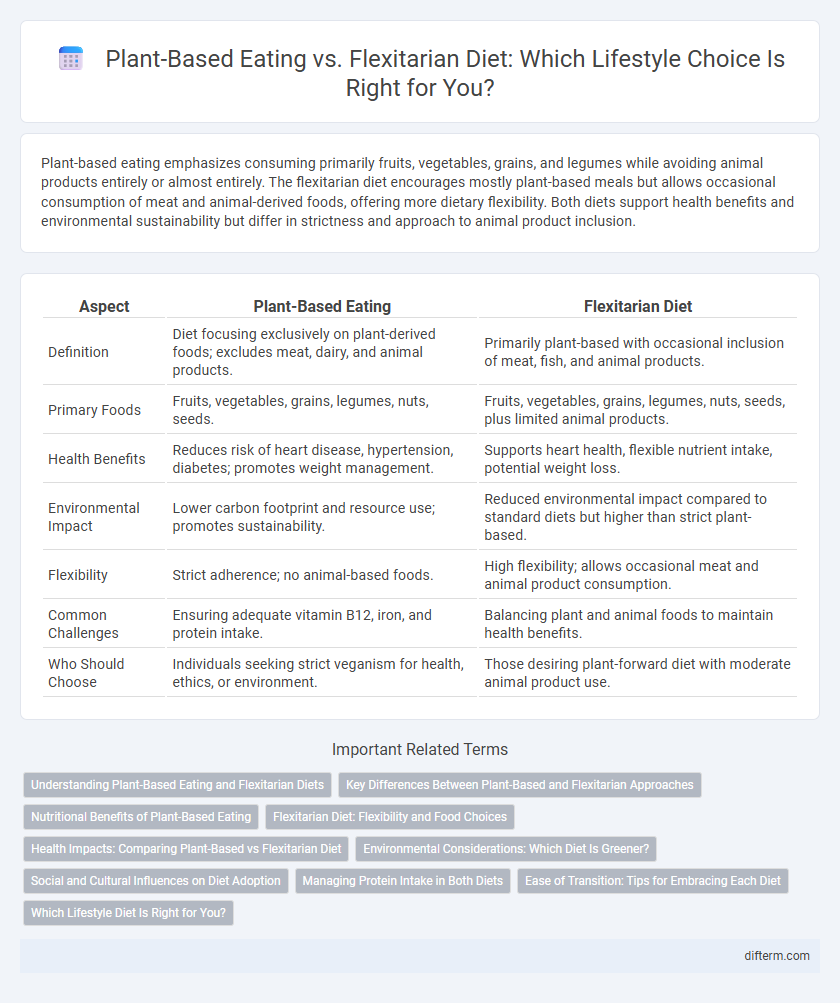Plant-based eating emphasizes consuming primarily fruits, vegetables, grains, and legumes while avoiding animal products entirely or almost entirely. The flexitarian diet encourages mostly plant-based meals but allows occasional consumption of meat and animal-derived foods, offering more dietary flexibility. Both diets support health benefits and environmental sustainability but differ in strictness and approach to animal product inclusion.
Table of Comparison
| Aspect | Plant-Based Eating | Flexitarian Diet |
|---|---|---|
| Definition | Diet focusing exclusively on plant-derived foods; excludes meat, dairy, and animal products. | Primarily plant-based with occasional inclusion of meat, fish, and animal products. |
| Primary Foods | Fruits, vegetables, grains, legumes, nuts, seeds. | Fruits, vegetables, grains, legumes, nuts, seeds, plus limited animal products. |
| Health Benefits | Reduces risk of heart disease, hypertension, diabetes; promotes weight management. | Supports heart health, flexible nutrient intake, potential weight loss. |
| Environmental Impact | Lower carbon footprint and resource use; promotes sustainability. | Reduced environmental impact compared to standard diets but higher than strict plant-based. |
| Flexibility | Strict adherence; no animal-based foods. | High flexibility; allows occasional meat and animal product consumption. |
| Common Challenges | Ensuring adequate vitamin B12, iron, and protein intake. | Balancing plant and animal foods to maintain health benefits. |
| Who Should Choose | Individuals seeking strict veganism for health, ethics, or environment. | Those desiring plant-forward diet with moderate animal product use. |
Understanding Plant-Based Eating and Flexitarian Diets
Plant-based eating emphasizes consuming primarily whole, minimally processed vegetables, fruits, grains, nuts, and legumes while excluding or minimizing animal products entirely. Flexitarian diets combine the benefits of plant-based nutrition with occasional intake of meat, fish, or dairy, promoting flexibility and balanced eating patterns. Both approaches support improved heart health, weight management, and environmental sustainability, catering to different lifestyle preferences and nutritional needs.
Key Differences Between Plant-Based and Flexitarian Approaches
Plant-based eating emphasizes consumption of fruits, vegetables, grains, nuts, and legumes while minimizing or eliminating animal products entirely. Flexitarian diets promote mostly plant-based foods but allow occasional inclusion of meat, dairy, and eggs, offering more dietary flexibility. The key difference lies in strictness: plant-based is often fully vegetarian or vegan, whereas flexitarian adapts animal products in moderation to fit individual preferences and nutritional needs.
Nutritional Benefits of Plant-Based Eating
Plant-based eating delivers abundant nutrients, including fiber, antioxidants, and essential vitamins like vitamin C and folate, which support immune function and reduce chronic disease risks. Rich in plant proteins, legumes, nuts, and seeds promote heart health and improve digestive health through high fiber content. This diet also typically features lower saturated fat and cholesterol levels, contributing to better cardiovascular outcomes compared to more flexible dietary patterns.
Flexitarian Diet: Flexibility and Food Choices
The flexitarian diet balances plant-based foods with occasional animal products, offering flexibility that suits diverse dietary preferences and lifestyles. This approach enhances nutrient variety by combining vegetables, fruits, legumes, whole grains, and moderate amounts of meat, fish, or dairy. Emphasizing adaptability, the flexitarian diet supports health benefits like improved heart health and weight management without strict restrictions.
Health Impacts: Comparing Plant-Based vs Flexitarian Diet
Plant-based diets emphasize whole fruits, vegetables, legumes, nuts, and seeds, promoting lower risks of heart disease, obesity, and type 2 diabetes due to their high fiber and antioxidant content. Flexitarian diets combine predominantly plant-based foods with occasional meat and animal products, providing balanced nutrient intake while still supporting cardiovascular health and weight management. Research indicates both diets improve metabolic health markers, but plant-based diets may offer greater reductions in cholesterol and inflammation levels.
Environmental Considerations: Which Diet Is Greener?
Plant-based eating typically results in lower greenhouse gas emissions, reduced water usage, and less land degradation compared to flexitarian diets due to the elimination of animal products. Flexitarian diets, which incorporate occasional meat consumption, still offer environmental benefits over traditional omnivorous diets by promoting reduced meat intake and increased plant foods. Scientific studies show that fully plant-based diets can reduce carbon footprints by up to 50%, making them generally greener than flexitarian approaches.
Social and Cultural Influences on Diet Adoption
Social networks and cultural traditions heavily shape the adoption of plant-based and flexitarian diets by influencing food choices and meal patterns within communities. Urban areas with diverse populations tend to show higher acceptance of plant-based eating due to exposure to global cuisines and environmental awareness. Media representation, peer support, and cultural festivals also play significant roles in normalizing these diets and encouraging shifts away from traditional meat-centric meals.
Managing Protein Intake in Both Diets
Managing protein intake in plant-based eating requires careful selection of diverse sources such as legumes, nuts, seeds, tofu, and quinoa to ensure adequate amino acid profiles. Flexitarian diets allow occasional consumption of animal proteins like poultry, fish, or dairy, offering a broader spectrum of complete proteins while maintaining predominantly plant-based meals. Both diets benefit from monitoring protein quantity and quality to support muscle maintenance and overall health.
Ease of Transition: Tips for Embracing Each Diet
Transitioning to a plant-based diet can be simplified by gradually replacing animal products with legumes, whole grains, and vegetables, while experimenting with plant-based recipes to maintain flavor and satisfaction. Flexitarian eating encourages flexibility by incorporating mostly plant-based meals alongside occasional animal products, making it easier to adapt without strict restrictions or intense planning. Focusing on meal prepping, exploring diverse cuisines, and increasing plant-based protein intake supports sustainable change and reduces the risk of nutrient deficiencies during this dietary shift.
Which Lifestyle Diet Is Right for You?
Choosing between a plant-based eating plan and a flexitarian diet depends on personal health goals, dietary preferences, and environmental concerns. Plant-based diets emphasize whole, minimally processed vegetables, fruits, legumes, and grains, promoting heart health and weight management. The flexitarian approach allows occasional inclusion of animal products, providing dietary flexibility and easier social adaptation while still encouraging plant-forward meals.
Plant-based eating vs Flexitarian diet Infographic

 difterm.com
difterm.com